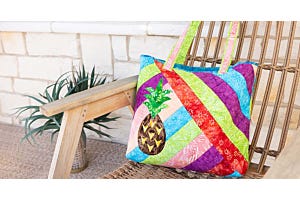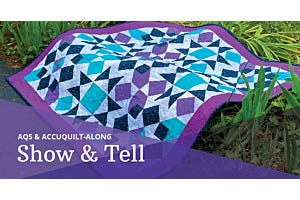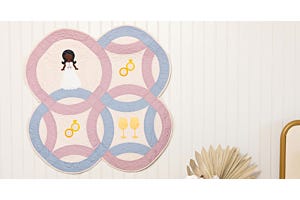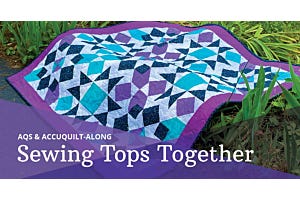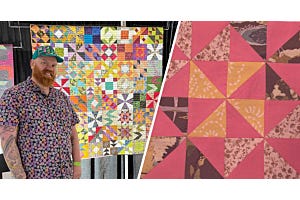.jpg)
You have likely had a lot of questions throughout your learning process as a beginner quilter. Now that you have finished sewing your project together, you have more questions about what type of batting you should get to give your work that polished look.
In case you don’t know, batting is the layer of material between your completed quilt top and backing. Selecting the right batting has major effects on the way your finished quilt looks, feels and ages. Let’s look at the features of batting to simplify your shopping trip and help you get the confidence to finish that project!
What is Batting?
Batting is the material that gives quilts their weight and coziness. It comes in various thicknesses (called loft), colors and materials.
Let's look at batting characteristics and how they affect a quilt.
- Loft: The thickness of the batting. The higher the loft, the lower the drapability (stiffness or softness of the quilt in total).
- Grain: Just like fabric grain, batting has a grain line. Lengthwise is stronger while crosswise is stretchy. Match the batting grain to the fabric grain and quilt lengthwise first to limit distortion.
- Resiliency: A batting's ability to resist creasing. Generally, cotton batting is less resilient and prone to creasing while polyester is more resilient to creasing.
- Warmth: Batting material affects how warm the quilt will be. For example, cotton absorbs moisture and offers a cooling effect versus polyester, which has less breathability and provides more warmth.
- Shrinkage/Washability: Some batting materials resists shrinking while others can shrink anywhere from 3% to 5%. Often, cotton will shrink more than polyester and wool. Keep in mind that Modern quilt batting is designed to resist shrinking. However, you can prewash your batting or, if you enjoy the antique look, you can wash after the quilt is completed to create a fluffy pucker.
Other Words to Know
- Scrim: A grid of polyester/synthetic fibers added to natural fiber batting, usually cotton, to stabilize the fibers. It helps keep the fibers together through sewing and it's life as a quilt.
- Bearding: When batting fibers migrate through the quilt fabric and appear as small pills or fluff. Typically, loosely woven fabric causes bearding, but it can also be the material and fabric combination or brand.
- Drapability: The density/sparseness of a batting loft can affect the drape stiffness or softness of the quilt. The density of the quilting can also affect the drapability, so it's important to consider both when planning your project.
Prepackaged Batting Sizes
Batting is packaged according to what would be needed for standard sized quilts. In other words, crib, twin, full, queen and king. Notice how the finished size of the quilt is smaller than the batting size. That’s because you will need the batting to be larger than the quilt top.
Save and reuse your batting scraps with this tried and true "Frankenbatting" tutorial from GO! Getter, Rachel at Wren Collective.
Here is the breakdown:
| Quilt Type | Approximate Quilt Size | Batting Size |
| Crib | 39" x 54" | 45" x 60" |
| Twin | 65" x 88" | 72" x 90" |
| Full | 80" x 88" | 81" x 96" |
| Queen | 86" x 93" | 90" x 108" |
| King | 104" x 93" | 120" x 120" |
Quilt Batting Materials
Selecting the batting material is an important decision in the process. Below are the basic batting materials and what they typically look like in a quilt. It's important to note that the brand can also influence results, so be sure to read the label for recommendations and ask fellow quilters for their own experiences.
100% Cotton
- Best known for shrinkage that creates an antique look
- Resists bearding (fibers shifting)
- Breathable
- Available in a variety of lofts (becomes more drapable with time/washing)
- Fine for experienced hand quilters, but can be dense for beginners
Cotton/Polyester Blend
- Some shrinking (usually can be prewashed)
- Resists bearding
- Mix of natural fibers help breathability
- Low to medium loft with high drapability
- Good for hand quilting of all experience levels
Polyester
- Resilient, light weight and resistant to mildew/moths
- Prone to bearding
- Synthetic materials have low breathability
- Available in many lofts
- Suitable for hand and machine quilting of all levels
Wool & Wool Blends
- Blends natural animal fibers of different breeds
- High warmth and drapability (rarely shows creases from folding)
- Prone to Bearding
- May have inconsistent loft and may need additional treatment
- Good for hand quilting
- Usually pricey
Bamboo & Bamboo Blends
- Natural fibers with antibacterial properties and eco-friendly
- Resistant to mildew and dries fast after washing
- Lightweight with thin scrim and smooth drape
- Good for machine quilting
- Pricey with limited sizes and availability
Flannel (100% Cotton)
- Lightweight and thin (low loft)
- Good for machine quilting
- Limits quilting pattern definition
Fusible
- No prewashing necessary
- Good for machine quilting and smaller projects (difficult for hand quilting)
- Eliminates the need for basting
- Limited options for size and material
Silk
- Resists shrinking
- Lightweight and nice drape
- Great for quilted garments
- Is pricey and can be damaged by direct sunlight
Want to go green? Check out Quilter's Dream Green made 100% from recycled plastic bottles.
Choosing the Right Batting
The above characteristics are all important to consider when choosing the right batting for your quilt. Consider what direction you plan to take your quilt, and use a batting that best supports the use and look you want. Will it be a lot of dark fabrics? You might want to choose a dark batting to account for potential bearding. What season will you hope to use your quilt the most? For colder seasons, you might want a higher warmth while summer quilts should be more breathable. Even the quilting technique affects the overall finished look of each batting.
If you are still unsure, take a trip to your local quilt shop. They will be happy to help you decide what is best for your particular project. They can also give you insights about brands based on their own experience.
Make sure you know the following info so they can help you:
- Finish size
- Quilting technique (hand, machine, tying or long arm)
- Stitch distance (dense or sparse stitching)
- Desired warmth (or season you want to use your quilt in)
- Fabric colors (majority light or dark)
Looking for a beginner-friendly quilt pattern? Give the FREE GO! Quilt pattern customizer a try! Color placement and fabric selecting can be hard, but GO! Quilt makes that easier and provides a downloadable pattern. If you create something using the platform, share it with us on Facebook!


